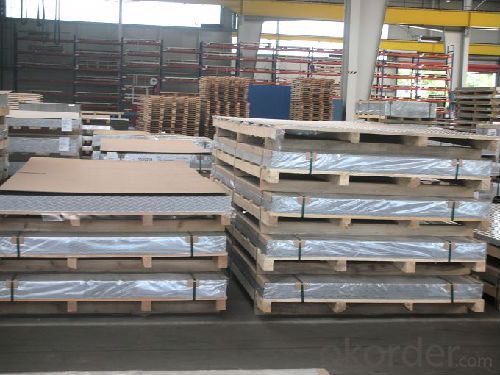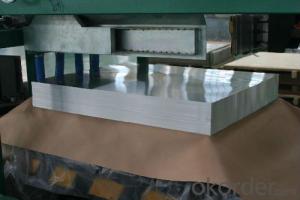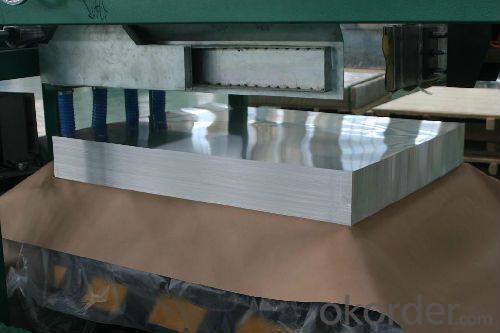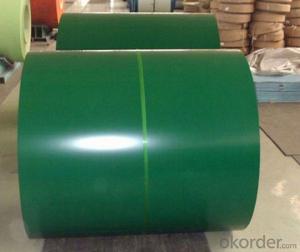Painted Anodized 1050 1100 Aluminum Sheets - Minerals & Metallurgy Material
- Loading Port:
- Shanghai
- Payment Terms:
- TT OR LC
- Min Order Qty:
- 5 m.t.
- Supply Capability:
- 9000 m.t./month
OKorder Service Pledge
OKorder Financial Service
You Might Also Like
Specification
1. Production Description
Product name | Minerals & Metallurgy material 1050 1100 aluminum strip |
Alloy | 1050/1060/1070/1100/3003/3004/3103/3104/5005/5052/5083/5182/5754/6005/6061/6063/8011,etc. |
Thickness | (0.15-6.0)mm,(8-30)mm,maximum |
Width | 1000/1220/1250/1300/1350/1500/2000mm(maximum),and other special width |
Length | 2000/2400/2440/2500/3000/4000/5000/6000mm,etc |
Thicnk tolerance | +/-0.03mm |
Temper | HO/H14/H24/H16/H18/H19/H32/H111/H112/T6/T651,etc |
Application | Construction, decoration, electronic products, wall Cladding, Truck body, Signboard, Insulation, Ceiling, aerospace,aviation, household appliance, lighting, and some other areas,etc. |
MOQ | 5-7tons for each thickness |
Packing | Export standard wooden pallets packing |
Surface | Mill finish |


2.Packaging & Delivery
| Packaging Details: | standard seaworthy exporting carton, Wooden pallets,waterproof paper and plastic coverage or or as per customer's requirements |
| Delivery Detail: | about 20 days from received oiginal L/C or advance payment. |

- Q: What is the main influence of the spacing?What are the main effects of spacing?
- Thermal explosion is related to a lot of factors. As to how much impact the lining board has on the thermal explosion, it's really impossible to speak of it. I think it has very little influence
- Q: Are the aluminum sheets suitable for manufacturing aircraft fuselages?
- Yes, aluminum sheets are suitable for manufacturing aircraft fuselages. Aluminum is widely used in the aerospace industry due to its excellent strength-to-weight ratio, corrosion resistance, and easy formability. It provides structural integrity while keeping the weight of the fuselage low, making it an ideal material choice for aircraft manufacturing.
- Q: As for graphite and aluminum sheet, which one has a better thermal conductivity?
- aluminum sheet
- Q: How much is the aluminum plate with a thick 2mm 1000*2000? Thanks
- (the current price of aluminum ingot is about: 15000 yuan / ton, plus board processing fee 2000/ tons, =18000 yuan / ton), the proportion of 2.71*3mm* aluminum plate price 18 yuan / kg, =146.34 yuan / square. 2MM*2.71* price 18 yuan =97.26 yuan / square.
- Q: How does the thickness tolerance of aluminum sheet affect its usability?
- The thickness tolerance of aluminum sheet plays a significant role in its usability. A narrow thickness tolerance ensures uniformity and precision in the sheet's dimensions, allowing for consistent performance and ease of fabrication. It enables seamless integration into various applications, including construction, automotive, aerospace, and manufacturing industries. On the other hand, a wider thickness tolerance can limit its usability as it may result in irregularities, difficulty in fitting, and potential performance issues. Therefore, a tight thickness tolerance is crucial for ensuring optimal functionality and versatility of aluminum sheets.
- Q: Are aluminum sheets suitable for hydraulic applications?
- Yes, aluminum sheets are suitable for hydraulic applications. Aluminum is known for its excellent strength-to-weight ratio, corrosion resistance, and high thermal conductivity, making it a suitable material for hydraulic systems. It is commonly used in the construction of hydraulic tanks, cylinders, and other components due to its durability and ability to withstand high pressure and fluid flow.
- Q: How do aluminum sheets compare to other metals?
- When comparing aluminum sheets to other metals, several advantages can be identified. Firstly, aluminum is known for its lightweight properties, making it an excellent option for industries that prioritize weight, such as aerospace. Moreover, aluminum exhibits exceptional resistance to corrosion, allowing it to endure exposure to moisture and chemicals without deterioration. As a result, aluminum sheets are suitable for outdoor use and in environments with high humidity or corrosive substances. Additionally, aluminum possesses excellent thermal and electrical conductivity, making it a popular choice for applications that require efficient heat dissipation or electrical conduction, including heat sinks and electrical enclosures. Furthermore, aluminum sheets can be easily manipulated and formed, providing versatility in various manufacturing processes. They can be effortlessly bent, cut, welded, and machined, making them highly adaptable to different design specifications. When considering cost, aluminum generally proves to be more affordable compared to other metals like steel or copper. This affordability makes it a cost-effective option for numerous industries, particularly for large-scale production or projects with budget constraints. However, it is vital to note that aluminum sheets may not be suitable for applications that demand high strength or extreme temperatures, as aluminum has lower strength and melting points in comparison to certain other metals. In such cases, metals such as steel or titanium may be more appropriate. In conclusion, aluminum sheets possess a combination of qualities, including lightweight properties, corrosion resistance, good conductivity, versatility, and affordability, which make them a preferred choice in many industries. Nevertheless, it is crucial to consider the specific requirements of a project or application to determine if aluminum sheets are the most suitable option or if another metal would be more appropriate.
- Q: Are 101 aluminum sheets suitable for outdoor signage?
- Yes, 101 aluminum sheets are suitable for outdoor signage. They are corrosion-resistant, durable, and can withstand various weather conditions, making them a suitable choice for outdoor applications.
- Q: What is the maximum width available for aluminum sheets?
- The maximum width available for aluminum sheets varies depending on the supplier and the specific requirements. However, standard widths for aluminum sheets typically range from 36 inches to 72 inches.
- Q: How do aluminum sheets perform in terms of chemical resistance?
- Aluminum sheets generally have good chemical resistance properties. However, their performance can vary depending on the specific chemical environment and conditions. Aluminum is known to have excellent resistance to corrosion from most acids, alkalis, and organic solvents. It forms a protective oxide layer on its surface, which prevents further reaction with many chemicals. However, aluminum can be susceptible to corrosion in certain aggressive environments, such as strong acids like hydrochloric acid or sulfuric acid, and alkaline solutions with high pH levels. In these cases, the protective oxide layer may break down, leading to the degradation of the aluminum surface. Additionally, some chemicals, like mercury and certain salts, can also cause localized corrosion or pitting on aluminum surfaces. Therefore, it is important to consider the specific chemicals and concentrations that the aluminum sheets will be exposed to when assessing their chemical resistance performance. To enhance the chemical resistance of aluminum sheets, various surface treatments, coatings, or alloys can be applied. These modifications can provide additional protection against specific chemicals or environmental conditions, further improving the overall chemical resistance properties of aluminum sheets. In summary, aluminum sheets generally exhibit good chemical resistance, but their performance can be influenced by the specific chemical environment and conditions. It is advisable to assess the compatibility of aluminum with the intended chemicals and consider appropriate surface treatments or coatings if necessary.
Send your message to us
Painted Anodized 1050 1100 Aluminum Sheets - Minerals & Metallurgy Material
- Loading Port:
- Shanghai
- Payment Terms:
- TT OR LC
- Min Order Qty:
- 5 m.t.
- Supply Capability:
- 9000 m.t./month
OKorder Service Pledge
OKorder Financial Service
Similar products
Hot products
Hot Searches
Related keywords




























